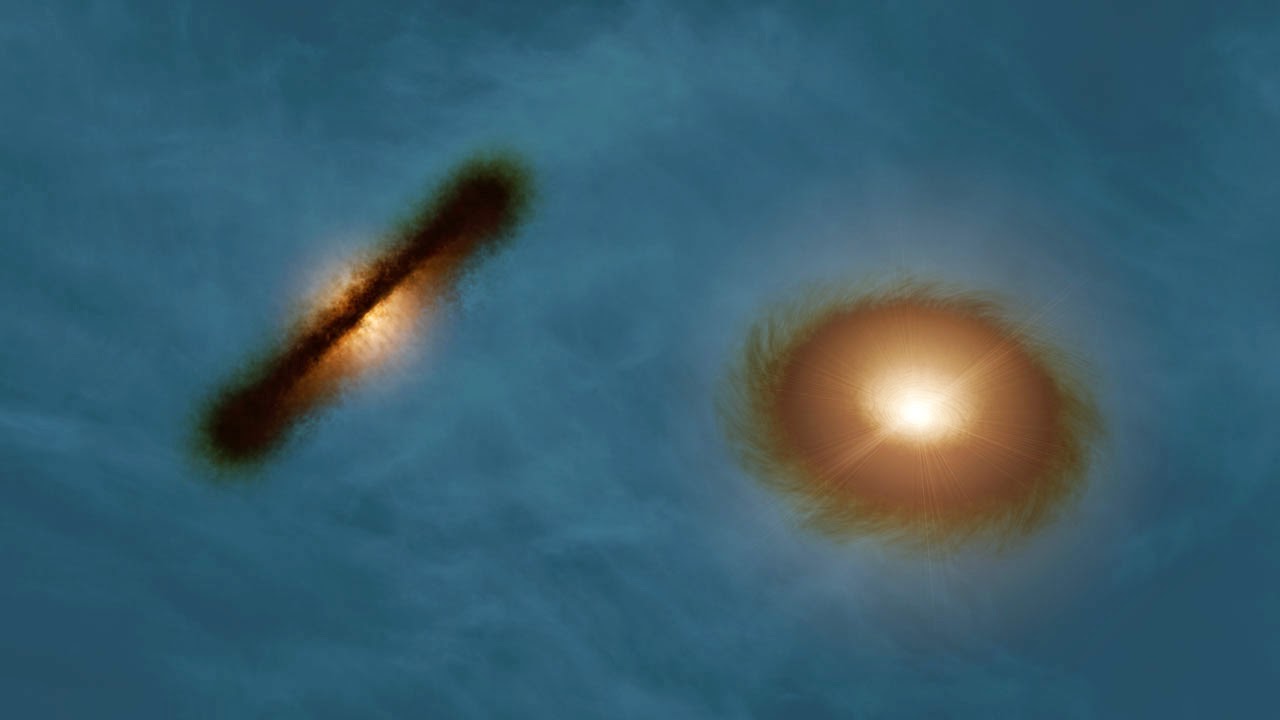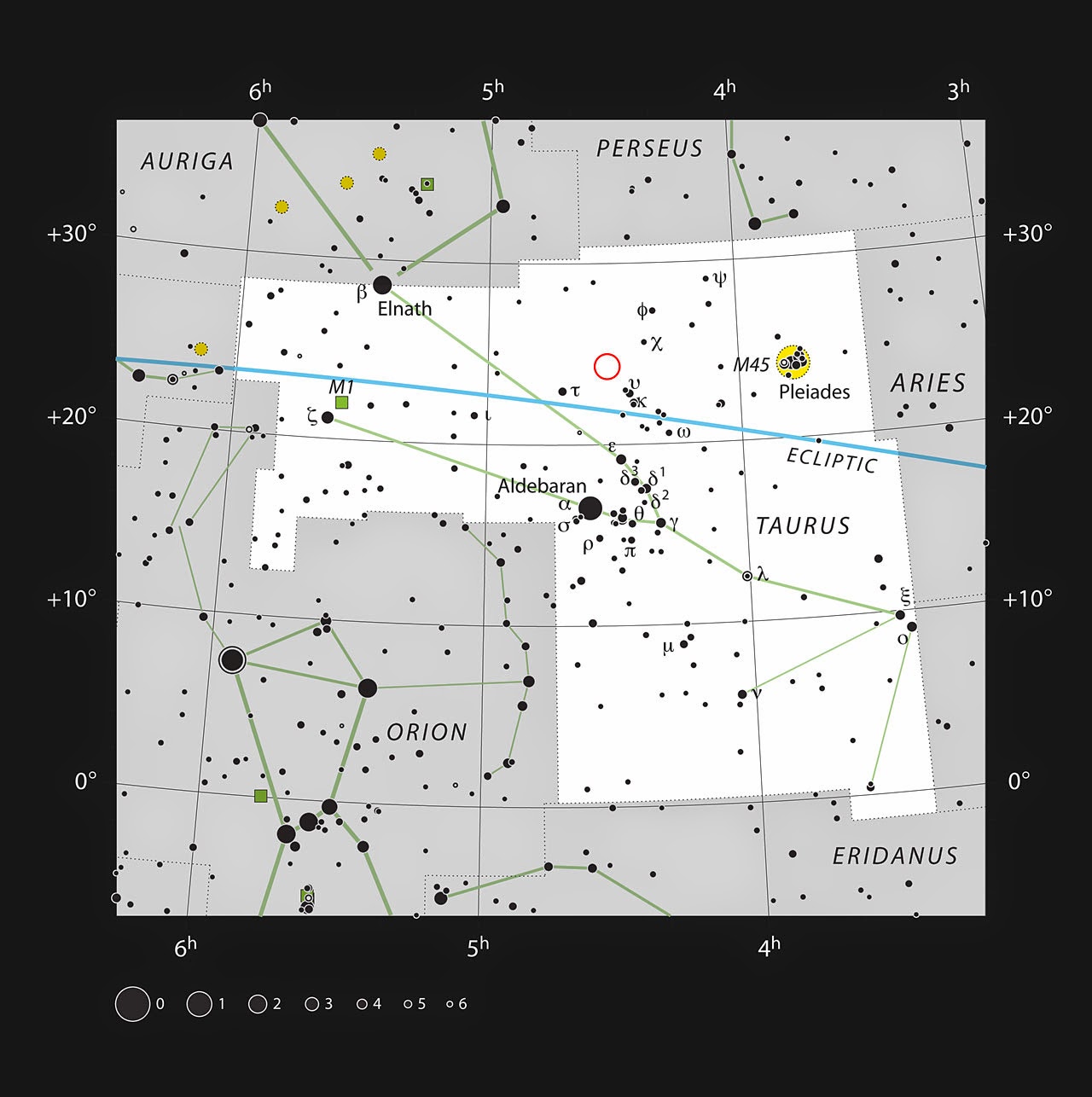ESO - European Southern Observatory logo.
30 July 2014
Astronomers using the Atacama Large Millimeter/submillimeter Array (ALMA) have found wildly misaligned planet-forming gas discs around the two young stars in the binary system HK Tauri. These new ALMA observations provide the clearest picture ever of protoplanetary discs in a double star. The new result also helps to explain why so many exoplanets — unlike the planets in the Solar System — came to have strange, eccentric or inclined orbits. The results will appear in the journal Nature on 31 July 2014.
Artist’s impression of the discs around the young stars HK Tauri A and B
Unlike our solitary Sun, most stars form in binary pairs — two stars that are in orbit around each other. Binary stars are very common, but they pose a number of questions, including how and where planets form in such complex environments.
“ALMA has now given us the best view yet of a binary star system sporting protoplanetary discs — and we find that the discs are mutually misaligned!” said Eric Jensen, an astronomer at Swarthmore College in Pennsylvania, USA.
The two stars in the HK Tauri system, which is located about 450 light-years from Earth in the constellation of Taurus (The Bull), are less than five million years old and separated by about 58 billion kilometres — this is 13 times the distance of Neptune from the Sun.
The young double star HK Tauri in the constellation of Taurus
The fainter star, HK Tauri B, is surrounded by an edge-on protoplanetary disc that blocks the starlight. Because the glare of the star is suppressed, astronomers can easily get a good view of the disc by observing in visible light, or at near-infrared wavelengths.
The companion star, HK Tauri A, also has a disc, but in this case it does not block out the starlight. As a result the disc cannot be seen in visible light because its faint glow is swamped by the dazzling brightness of the star. But it does shine brightly in millimetre-wavelength light, which ALMA can readily detect.
Using ALMA, the team were not only able to see the disc around HK Tauri A, but they could also measure its rotation for the first time. This clearer picture enabled the astronomers to calculate that the two discs are out of alignment with each other by at least 60 degrees. So rather than being in the same plane as the orbits of the two stars at least one of the discs must be significantly misaligned.
Wide-field view of part of the Taurus star formation region
“This clear misalignment has given us a remarkable look at a young binary star system,” said Rachel Akeson of the NASA Exoplanet Science Institute at the California Institute of Technology in the USA. “Although there have been earlier observations indicating that this type of misaligned system existed, the new ALMA observations of HK Tauri show much more clearly what is really going on in one of these systems.”
Stars and planets form out of vast clouds of dust and gas. As material in these clouds contracts under gravity, it begins to rotate until most of the dust and gas falls into a flattened protoplanetary disc swirling around a growing central protostar.
Composite views of HK Tauri from Hubble and ALMA
But in a binary system like HK Tauri things are much more complex. When the orbits of the stars and the protoplanetary discs are not roughly in the same plane any planets that may be forming can end up in highly eccentric and tilted orbits [1].
“Our results show that the necessary conditions exist to modify planetary orbits and that these conditions are present at the time of planet formation, apparently due to the formation process of a binary star system,” noted Jensen. “We can’t rule other theories out, but we can certainly rule in that a second star will do the job.”
The motions of material in the discs around the young double star HK Tauri
Since ALMA can see the otherwise invisible dust and gas of protoplanetary discs, it allowed for never-before-seen views of this young binary system. “Because we’re seeing this in the early stages of formation with the protoplanetary discs still in place, we can see better how things are oriented,” explained Akeson.
Looking forward, the researchers want to determine if this type of system is typical or not. They note that this is a remarkable individual case, but additional surveys are needed to determine if this sort of arrangement is common throughout our home galaxy, the Milky Way.
Zooming in on the young double star HK Tauri
Jensen concludes: “Although understanding this mechanism is a big step forward, it can’t explain all of the weird orbits of extrasolar planets — there just aren’t enough binary companions for this to be the whole answer. So that’s an interesting puzzle still to solve, too!”
Notes:
[1] If the two stars and their discs are not all in the same plane, the gravitational pull of one star will perturb the other disc, making it wobble or precess, and vice versa. A planet forming in one of these discs will also be perturbed by the other star, which will tilt and deform its orbit.
More information:
The Atacama Large Millimeter/submillimeter Array (ALMA), an international astronomy facility, is a partnership of Europe, North America and East Asia in cooperation with the Republic of Chile. ALMA is funded in Europe by the European Southern Observatory (ESO), in North America by the U.S. National Science Foundation (NSF) in cooperation with the National Research Council of Canada (NRC) and the National Science Council of Taiwan (NSC) and in East Asia by the National Institutes of Natural Sciences (NINS) of Japan in cooperation with the Academia Sinica (AS) in Taiwan. ALMA construction and operations are led on behalf of Europe by ESO, on behalf of North America by the National Radio Astronomy Observatory (NRAO), which is managed by Associated Universities, Inc. (AUI) and on behalf of East Asia by the National Astronomical Observatory of Japan (NAOJ). The Joint ALMA Observatory (JAO) provides the unified leadership and management of the construction, commissioning and operation of ALMA.
This research was presented in a paper entitled “Misaligned Protoplanetary Disks in a Young Binary Star System”, by Eric Jensen and Rachel Akeson, to appear in the 31 July 2014 issue of the journal Nature.
The team is composed of Eric L. N. Jensen (Dept. of Physics & Astronomy, Swarthmore College, USA) and Rachel Akeson (NASA Exoplanet Science Institute, IPAC/Caltech, Pasadena, USA).
ESO is the foremost intergovernmental astronomy organisation in Europe and the world’s most productive ground-based astronomical observatory by far. It is supported by 15 countries: Austria, Belgium, Brazil, the Czech Republic, Denmark, France, Finland, Germany, Italy, the Netherlands, Portugal, Spain, Sweden, Switzerland and the United Kingdom. ESO carries out an ambitious programme focused on the design, construction and operation of powerful ground-based observing facilities enabling astronomers to make important scientific discoveries. ESO also plays a leading role in promoting and organising cooperation in astronomical research. ESO operates three unique world-class observing sites in Chile: La Silla, Paranal and Chajnantor. At Paranal, ESO operates the Very Large Telescope, the world’s most advanced visible-light astronomical observatory and two survey telescopes. VISTA works in the infrared and is the world’s largest survey telescope and the VLT Survey Telescope is the largest telescope designed to exclusively survey the skies in visible light. ESO is the European partner of a revolutionary astronomical telescope ALMA, the largest astronomical project in existence. ESO is currently planning the 39-metre European Extremely Large optical/near-infrared Telescope, the E-ELT, which will become “the world’s biggest eye on the sky”.
Links:
Research paper: http://www.eso.org/public/archives/releases/sciencepapers/eso1423/eso1423a.pdf
NRAO press release about HK Tauri results: https://public.nrao.edu/news/pressreleases/young-binary-star-system-form-planets-with-weird-orbits
Image of HK Tauri from the NASA/ESA Hubble Space Telescope: http://www.spacetelescope.org/images/opo9905m/
More about ALMA: http://www.eso.org/public/teles-instr/alma/
Photos of ALMA: http://www.eso.org/public/images/archive/category/alma/
Videos of ALMA: http://www.eso.org/public/videos/archive/category/alma/
ALMA brochure: http://www.eso.org/public/products/brochures/alma_brochure_en/
The movie ALMA — In Search of our Cosmic Origins: http://www.eso.org/public/videos/eso1312a/
The ALMA Photo Book In Search of our Cosmic Origins – The Construction of the Atacama Large Millimeter/submillimeter Array: http://www.eso.org/public/products/books/alma-photobook/
More press releases with ALMA: http://www.eso.org/public/news/archive/search/?adv=&facility=36
Images, Text, Credits: ESO/ALMA/R. Hurt (NASA/JPL-Caltech/IPAC)/IAU and Sky & Telescope/Digitized Sky Survey 2. Acknowledgement: Davide De Martin/B. Saxton (NRAO/AUI/NSF); K. Stapelfeldt et al. (NASA/ESA Hubble)/NASA/JPL-Caltech/R. Hurt (IPAC)/Video: ESO/Digitized Sky Survey 2/N. Risinger (skysurvey.org). Music: movetwo.
Best regards, Orbiter.ch






